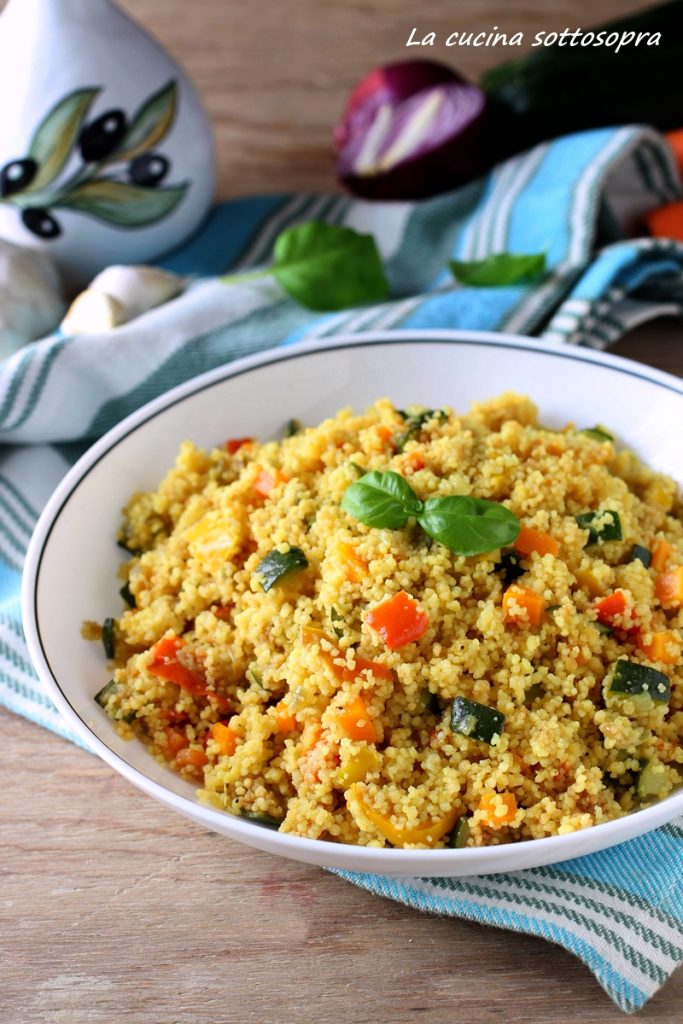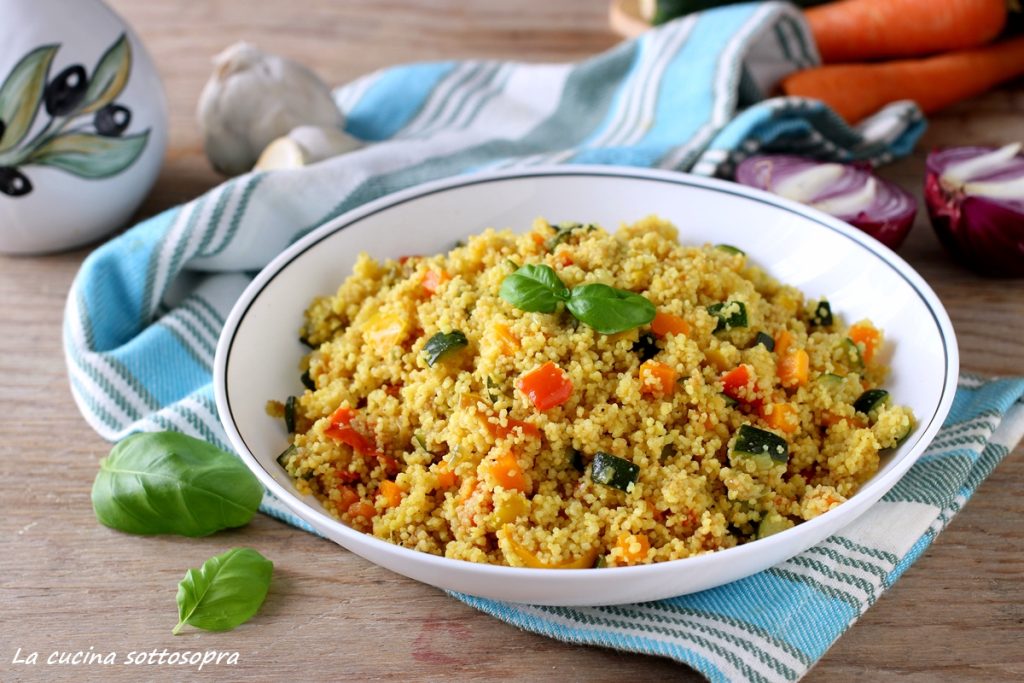The recipe for vegetable couscous (or couscous) is one I often prepare because it’s a quick first course, light, and very versatile. Quick, because couscous needs very few minutes to cook; light, because vegetables make it filling and satisfying; versatile, because you can use the vegetables you like best or have in the fridge.
I generally use whole wheat couscous for these types of recipes because I find it has a more intense flavor and better cooking stability, but classic semolina couscous works just fine.
You can also enrich the recipe of vegetable couscous with herbs or spices: besides classic pepper, you can try seasoning the dish with turmeric, curry, or some dried or fresh chili.
This first course can also be turned into a one-pot dish by adding proteins to the vegetables, such as mozzarella or small cubes of Parmesan, chickpeas, peas, fish, or meat, as I did in this recipe for couscous with chicken and vegetables.
As you may have noticed from these few lines, it’s a dish you can customize according to your tastes and is also a dish that can be enjoyed in all seasons because it’s great both hot and cold. This also makes it a perfect dish to take with you to the beach, work, or office.
Well then, let’s get straight to the recipe and see how it’s done! But first, I’ll leave you with some links to couscous recipes that might come in handy.

- Difficulty: Easy
- Cost: Very Cheap
- Preparation time: 20 Minutes
- Portions: 4 People
- Cooking methods: Stovetop
- Cuisine: Italian
- Seasonality: All Seasons
Ingredients to prepare vegetable couscous
- 2 1/3 cups cooked couscous
- 3 oz extra virgin olive oil (about 4-5 tablespoons)
- 1 red onion
- 1 carrot
- 1 zucchini
- 1 red bell pepper
- 1 yellow bell pepper
- to taste herbs (basil, parsley…)
- 1 clove garlic (optional)
- to taste salt
- to taste spices (pepper, curry, turmeric, paprika)
- 2 tablespoons soy sauce (optional)
- 1 1/4 cups water
- 4 teaspoons extra virgin olive oil
- 1 pinch salt
Tools for preparing vegetable couscous
- Bowl
- Cutting Board
- Knife
- Pan
Steps to prepare vegetable couscous
Let’s see together how to prepare vegetable couscous. It’s a very simple recipe; the only caution you’ll need for perfectly cooked vegetables is to not put all the vegetables together in the pan, but do it gradually, starting with those that take longer to cook and ending with the more tender ones.
Start by chopping the onion and garlic clove (which is optional, but I recommend adding it for more flavor).
Dice the carrots, peppers, and zucchini after washing and cleaning them properly. Since you will be adding them to the pan at different times, keep them separate.
Take a heavy-bottomed pan, pour in the oil, and heat it.
Start adding the carrots and peppers to the pan, cook for a few minutes, then add the chopped onion and garlic, and finally, the zucchini.
Cook over high heat, also adding herbs of your choice. I generally prefer chopped parsley and basil.
At the end of cooking, adjust the salt and pepper, turn off the heat, and set aside.
Weigh the couscous and place it in a large bowl.
In a separate saucepan, bring the water to a boil, using the same weight as the couscous (in this case, with 2 1/3 cups of couscous, you’ll use 1 1/4 cups of water). Add a pinch of salt and 4 teaspoons of oil to the water and bring to a boil.
Then pour it into the couscous bowl, stir quickly, and cover the bowl with a lid. Let the couscous rest for about 5 minutes. When all the water is absorbed, fluff the couscous with a fork.
Put the pan back on the heat with the cooked vegetables, add the couscous, and let it simmer for a few minutes.
If you decide to use spices and soy sauce to enrich your vegetable couscous, this is the time to add them. I recommend doing it little by little and tasting each time to adapt the dish to your liking. As my mother always says: “You can always add more, but it’s harder to take it out.” 🙂
At this point, the vegetable couscous is ready. It’s up to you to decide whether to eat it hot or let it cool and enjoy it as a cold dish. In either case, it won’t disappoint you!

Notes
– The vegetable couscous can be stored in the refrigerator and should be consumed within a couple of days.
– If you decide to add peas, I recommend blanching them for a few minutes before adding them to the pan with the other vegetables. Alternatively, you can use pre-cooked peas.
– If you decide to add peas, I recommend blanching them for a few minutes before adding them to the pan with the other vegetables. Alternatively, you can use pre-cooked peas.
FAQ
Do I have to use the vegetables listed in the recipe?
No, you can use the vegetables you prefer: in winter, you can try it with pumpkin, mushrooms, broccoli, cabbage, and so on.
If I don’t like spices or soy sauce, can they be omitted?
Sure, soy sauce and spices serve as “flavor enhancers” and give the dish a slightly ethnic taste, but if you don’t like them or aren’t used to using them, don’t. The vegetable couscous will be delicious even without them.

